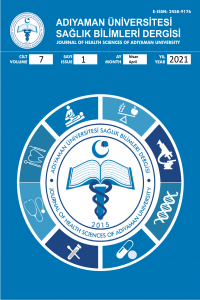Hemşirelik Öğrencilerinin Cerrahi Dren Takibi ve Bakımına Yönelik Bilgi Düzeyleri
Knowledge Levels of Nursing Students for Surgical Drain Follow up and Care
___
- 1. Durai R, Mownah A, Philip CN. Use of drains in surgery: a review. Journal of perioperative practice, 2009;19(6):180-186.
- 2. Yılmaz KB, Akıncı M, Şeker D, Güller M, Güneri G, Kulaçoğlu H. Factors affecting the safety of drains and catheters in surgical patients. Ulusal Cerrahi Dergisi 2014;30(2):90-92.
- 3. Čečka F, Loveček M, Jon B, Skalický P, Šubrt Z, Neoral C, Ferko A. Intra-abdominal drainage following pancreatic resection: A systematic review. World J Gastroenterology 2015;21(40):11458-68.
- 4. Brown MD, Brookfield KFW. A Randomized Study of Closed Wound Suction Drainage for Extensive Lumbar Spine Surgery. Spine 2004;29(10):1066-68.
- 5. Petrowsky H, Demartines N, Rousson V, Clavien P. Evidence-based value of prophylactic drainage in gastrointestinal surgery: a systematic review and meta-analyses. Annals of surgery 2004;240(6):1074-84.
- 6. Kehlet H, Wilmore DW. Evidence-based surgical care and the evolution of fast-track surgery. Annals of surgery 2008;248(2):189-98.
- 7. Lyons N, Heron P, Bethune R. Improving the recording of surgical drain output. BMJ Open Quality 2015;4(1):doi: 10.1136/bmjquality.u209264.w3964.
- 8. Crawford D. Care and nursing management of a child with a chest drain. Nursing children and young people 2011;23(10):27-34.
- 9. Sullivan B. Nursing management of patients with a chest drain. British journal of nursing 2008;17(6):388-393.
- 10. Durai R, Phılıp CH. Surgical vacum drains: types, uses, and complications. AORN journal 2010;91(2):266-74.
- 11. Tiwari A, McFarlane JP, Peters, JL. A simple technique for securing surgical drains. Injury Extra 2004;35(11):91-3.
- 12. Kuhajda I, Zarogoulidis K, Kougioumtzi I, Huang H, Li Q, Dryllis G, Kioumis I, Pitsiou G, Machairiotis N, Katsikogiannis N, Papaiwannou A, Lampaki S, Papaiwannou A, Zaric B, Branislav P, Porpodis P, Zarogoulidis P. Tube thoracostomy; chest tube implantation and follow up. J Thorac Dis 2014;6(4):470-9.
- 13. Lehwaldt D, Timmins F. Nurses’ knowledge of chest drain care: an exploratory descriptive survey. Nursing in critical care 2005;10(4):192-200.
- 14. Magner C, Houghton C, Craig M, Cowman, S. Nurses' knowledge of chest drain management in an Irish Children's Hospital. Journal of clinical nursing 2013;22(19-20):2912-22.
- 15. Ergin M, Yeğinsu A, Gürlek K. Göğüs tüpü takılması. Turkish Journal of Surgery/Ulusal Cerrahi Dergisi 2010;26(2):115-21.
- 16. Ling L, Guo L, Wang J, Zhang L, Zhu J, Huang Z. Nursing Management of Lumbar Drainage in Cryptococcal Meningitis: A Case Report. Journal of Neuroscience Nursing 2017;49(4):198-202.
- 17. Trotter M, Morgan D. Continuous lumbar drainage. Ann R Coll Surg Engl 2002;84(1):64–5.
- 18. Muralidharan R. External ventricular drains: management and complications. Surgical neurology international, 2015;6(6):271-4.
- 19. Tarhan M, Gökduman SA, Ayan A, Dalar L. Nurses’ Knowledge Levels of Chest Drain Management: A Descriptive Study. Eurasian Journal of Pulmonology 2016;18(3):153-9.
- 20. Briggs D. Nursing care and management of patients with intrapleural drains. Nursing Standard (through 2013) 2010;24(21):47-55.
- 21. Charnock Y, Evans D. Nursing management of chest drains: a systematic review. Aust Crit Care 2001;14(4):156-60.
- 22. Bruce EA. Chest drain removal pain and its management: a literature review. Blackwell Publishing Ltd, Journal of Clinical Nursing 2006;(15):145–54.
- 23. Patel SB, Griffiths-Jones W, Jones CS, Samartzis D, Clarke AJ, Khan S, Stokes OM. The current state of the evidence for the use of drains in spinal surgery: systematic review. European Spine Journal 2017;26(11):2729-38.
- 24. Puleo FJ, Mishra N, Hall JF. Use of intra-abdominal drains. Clinics in colon and rectal surgery 2013;26(3):174-7.
- 25. Walker J. Patient preparation for safe removal of surgical drains. Nursing standard 2007;21(49):39-41.
- 26. Liu Y, Li Y, Miao J. Wound drains in posterior spinal surgery: a meta-analysis. Journal of orthopaedic surgery and research, 2016;11(16): DOI 10.1186/s13018-016-0351-8
- 27. Mirzai H, Eminoglu M, Orguc S. Are drains useful for lumbar disc surgery? A prospective, randomized clinical study. Clinical Spine Surgery 2006;19(3):171-7.
- 28. Melnyk BM, Fineout‐Overholt E, Feinstein NF, Li H, Small L, Wilcox L, Kraus R. Nurses' Perceived Knowledge, Beliefs, Skills, and Needs Regarding Evidence‐Based Practice: Implications for Accelerating the Paradigm Shift. Worldviews on Evidence-Based Nursing 2004;1(3):185–93.
- 29. Hatlevik IKR. The theory-practice relationship: reflective skills and theoretical knowledge as key factors in bridging the gap between theory and practice in initial nursing education. Journal of Advanced Nursing 2011;68(4):868–77.
- 30. Angel BF, Duffey M, Belyea M. An evidence-based project for evaluating strategies to improve knowledge acquisition and critical-thinking performance in nursing students. Journal of Nursing Education 2000;39(5):219-28.
- Yayın Aralığı: Yılda 3 Sayı
- Başlangıç: 2015
- Yayıncı: ADIYAMAN ÜNİVERSİTESİ
HEMŞİRELERİN CERRAHİ HASTASININ BESLENMESİ KONUSUNDA BİLGİ, TUTUM VE UYGULAMALARININ İNCELENMESİ
Atipik Yerleşimli Septik Artrit Olgusu
Selçuk AKSÖZ, İbrahim İNAN, Şehmuz KAYA, Şenol ÇOMOĞLU
AŞILAMA TEDAVİSİ SONRASI OLUŞAN RÜPTÜRE OLMAMIŞ OVARYAN GEBELİK
Nur DOKUZEYLÜL GÜNGÖR, Tuğba GÜRBÜZ, Aynur ERŞAHİN, Suat Süphan ERŞAHİN, Özlem YAPICIER
Hemşirelik Öğrencilerinin Cerrahi Dren Takibi ve Bakımına Yönelik Bilgi Düzeyleri
Akif BULUT, Tuğba AFŞAR, Nursel VATANSEVER
Sezaryen sonrası nadir bir postoperatif komplikasyon: Tüberküloz Peritonit; Olgu Sunumu
Mehmet BÜLBÜL, Mustafa GÖKSU, Tuğba MANDAL, Berna DİLBAZ
Açık kalp cerrahisinde geleneksel yönteme alternatif sternum kapama tekniğimiz
Arda Aybars PALA, Hasan İNER, Murat Abdulhamit ERCİŞLİ
Ahmet onur Derin, Umut UNCU, Mahmut BOZKURT, Nazan ÇELİK, Fatoş UNCU, İhsan HALİFEOĞLU
Mehmet BÜLBÜL, Esra Boyar, İpek Çakılkaya, Selahaddin AKAR, Berna Dilbaz
Günübirlik Cerrahide Hasta Konforu Ve Hasta Konforunu Etkileyen Etmenler
Murat Eren ÖZEN, Aysun KALENDEROĞLU, Mustafa ÇELİK, Mehmet Hamdi ÖRÜM, Çiçek HOCAOĞLU
